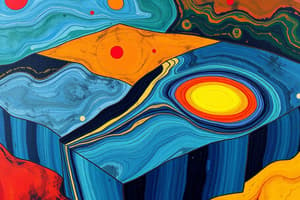Podcast
Questions and Answers
What is the primary cause of earthquakes?
What is the primary cause of earthquakes?
- Tidal forces
- Volcanic eruptions
- Meteorite impacts
- Tectonic plate movement (correct)
What instrument is used to measure the magnitude of an earthquake?
What instrument is used to measure the magnitude of an earthquake?
- Hygrometer
- Thermometer
- Seismograph (correct)
- Barometer
What is the point on the Earth's surface directly above the focus of an earthquake called?
What is the point on the Earth's surface directly above the focus of an earthquake called?
- Seismic zone
- Epicenter (correct)
- Fault line
- Focus
Which scale is most commonly used to measure the magnitude of earthquakes?
Which scale is most commonly used to measure the magnitude of earthquakes?
What type of fault is characterized by horizontal movement of blocks of crust?
What type of fault is characterized by horizontal movement of blocks of crust?
What is the term for a series of ocean waves caused by an underwater earthquake or volcanic eruption?
What is the term for a series of ocean waves caused by an underwater earthquake or volcanic eruption?
Which of the following is a primary effect of an earthquake?
Which of the following is a primary effect of an earthquake?
What is the name given to smaller earthquakes that follow a larger earthquake in the same area?
What is the name given to smaller earthquakes that follow a larger earthquake in the same area?
Which of these materials is safest to have a structure built of in an earthquake prone area?
Which of these materials is safest to have a structure built of in an earthquake prone area?
Which earthquake safety measure is most important to undertake before an earthquake?
Which earthquake safety measure is most important to undertake before an earthquake?
What is the focus of an earthquake?
What is the focus of an earthquake?
What type of seismic wave travels fastest?
What type of seismic wave travels fastest?
Which is a region known for frequent earthquakes?
Which is a region known for frequent earthquakes?
What type of damage to buildings is most likely during an earthquake?
What type of damage to buildings is most likely during an earthquake?
What should you do if an earthquake occurs while you are indoors?
What should you do if an earthquake occurs while you are indoors?
The San Andreas Fault is located in which state?
The San Andreas Fault is located in which state?
What causes a tsunami?
What causes a tsunami?
Which of the following is NOT a result of earthquakes?
Which of the following is NOT a result of earthquakes?
What is the name for smaller magnitude earthquakes that happens before a larger one?
What is the name for smaller magnitude earthquakes that happens before a larger one?
What is the term for ground deformation associated with earthquakes?
What is the term for ground deformation associated with earthquakes?
Flashcards
Earthquake
Earthquake
A sudden and violent shaking of the ground caused by movements within the Earth's crust or volcanic action.
Study Notes
- An earthquake is the shaking of the surface of the Earth, resulting from the sudden release of energy in the Earth's lithosphere that creates seismic waves.
- Earthquakes can range in size from those that are so weak that they cannot be felt to those violent enough to toss people around and destroy whole cities.
- Seismicity or seismic activity refers to the frequency, type, and size of earthquakes experienced over a period of time.
Causes of Earthquakes
- Earthquakes are primarily caused by the rupture of geological faults, but also by other events such as volcanic activity, landslides, mine blasts, and nuclear tests.
Plate Tectonics
- The Earth's lithosphere is divided into several tectonic plates that constantly move and interact.
- The boundaries where these plates interact are zones where earthquakes often occur.
- Types of plate boundaries include:
- Convergent: Plates collide, one may slide under the other (subduction), or they may crumple and create mountains.
- Divergent: Plates move apart, allowing magma to rise from the Earth's interior to create new crust.
- Transform: Plates slide past each other horizontally.
Faults
- A fault is a fracture or zone of fractures between two blocks of rock.
- Faults allow the blocks to move relative to each other.
- This movement may occur rapidly, in the form of an earthquake, or slowly, in the form of creep.
- Types of faults include:
- Normal faults: Occur where the crust is extending, the hanging wall moves down relative to the footwall.
- Reverse faults: Occur where the crust is shortening, the hanging wall moves up relative to the footwall. A thrust fault is a reverse fault with a low angle.
- Strike-slip faults: Occur where the crust is sliding past each other horizontally.
Seismic Waves
- Seismic waves are vibrations that travel through the Earth carrying the energy released during an earthquake.
- Types of seismic waves include:
- P-waves (Primary waves): Compressional waves that can travel through solid, liquid, and gas. They are the fastest seismic waves.
- S-waves (Secondary waves): Shear waves that can only travel through solids. They are slower than P-waves.
- Surface waves: Travel along the Earth's surface and are the slowest and most destructive seismic waves. Examples include Love waves and Rayleigh waves.
Earthquake Measurement
- Earthquakes are measured using seismographs, which record the ground motion.
- The magnitude of an earthquake is a measure of the energy released.
- The Richter scale was one of the first magnitude scales, but it has been superseded by the moment magnitude scale, which provides a more accurate measure of large earthquakes.
- Intensity scales, such as the Modified Mercalli scale, measure the effects of an earthquake on people, structures, and the natural environment.
Earthquake Prediction and Forecasting
- Earthquake prediction, in the sense of specifying the exact time, location, and magnitude of a future earthquake, is not currently possible.
- Earthquake forecasting involves estimating the probability of an earthquake of a certain magnitude occurring in a specific area over a period of time.
- Forecasts are based on factors such as historical seismicity, fault locations, and stress accumulation.
- Earthquake early warning systems can detect P-waves and provide a few seconds to a minute of warning before the arrival of the more destructive S-waves and surface waves.
Earthquake Effects
- Ground shaking can cause buildings to collapse, bridges to fail, and landslides to occur.
- Surface rupture can damage or destroy structures that are built across fault lines.
- Liquefaction occurs when saturated soil loses its strength and behaves like a liquid, causing buildings and other structures to sink or tilt.
- Tsunamis are large ocean waves caused by undersea earthquakes. They can cause widespread destruction in coastal areas.
- Landslides and rockfalls can be triggered by earthquakes, especially in mountainous areas.
- Fires can be started by earthquakes due to broken gas lines and downed power lines.
Earthquake Preparedness
- Preparing for earthquakes can reduce the risk of injury and damage.
- Recommendations include:
- Securing furniture and appliances to prevent them from falling.
- Developing an emergency plan and practicing earthquake drills.
- Assembling an emergency kit with food, water, first aid supplies, and other essentials.
- Knowing how to shut off gas, water, and electricity.
- Identifying safe spots in your home or workplace, such as under sturdy furniture or against interior walls.
Notable Earthquakes
- The 1960 Valdivia earthquake in Chile was the largest earthquake ever recorded, with a magnitude of 9.5.
- The 1964 Alaska earthquake was the largest earthquake in North American history, with a magnitude of 9.2.
- The 2004 Indian Ocean earthquake triggered a massive tsunami that killed hundreds of thousands of people in several countries.
- The 2011 Tōhoku earthquake in Japan caused a major tsunami and a nuclear accident at the Fukushima Daiichi Nuclear Power Plant.
Induced Seismicity
- Earthquakes can be induced by human activities, such as:
- Reservoir impoundment: The weight of water in a reservoir can increase stress on underlying faults.
- Fracking: The injection of fluids into the Earth to extract oil and gas can increase pore pressure and trigger earthquakes.
- Mining: The removal of rock and the creation of underground voids can destabilize the Earth's crust.
- Deep well injection: The disposal of wastewater into deep wells can increase pore pressure and trigger earthquakes.
Earthquake Engineering
- Earthquake engineering is a multidisciplinary field that aims to design and construct buildings and other structures that can withstand earthquakes.
- Earthquake-resistant design incorporates features such as:
- Base isolation: Isolating the structure from the ground using flexible bearings.
- Damping systems: Absorbing energy from the earthquake to reduce shaking.
- Reinforcement: Strengthening the structure with steel or other materials.
Earthquake Monitoring and Research
- Scientists monitor earthquakes using a global network of seismographs.
- Data from seismographs is used to study the Earth's interior, map fault lines, and develop earthquake hazard assessments.
- Research is ongoing to improve our understanding of earthquakes and develop better methods for predicting and mitigating their effects.
- This includes studying fault mechanics, developing new seismic imaging techniques, and improving earthquake early warning systems.
Studying That Suits You
Use AI to generate personalized quizzes and flashcards to suit your learning preferences.




